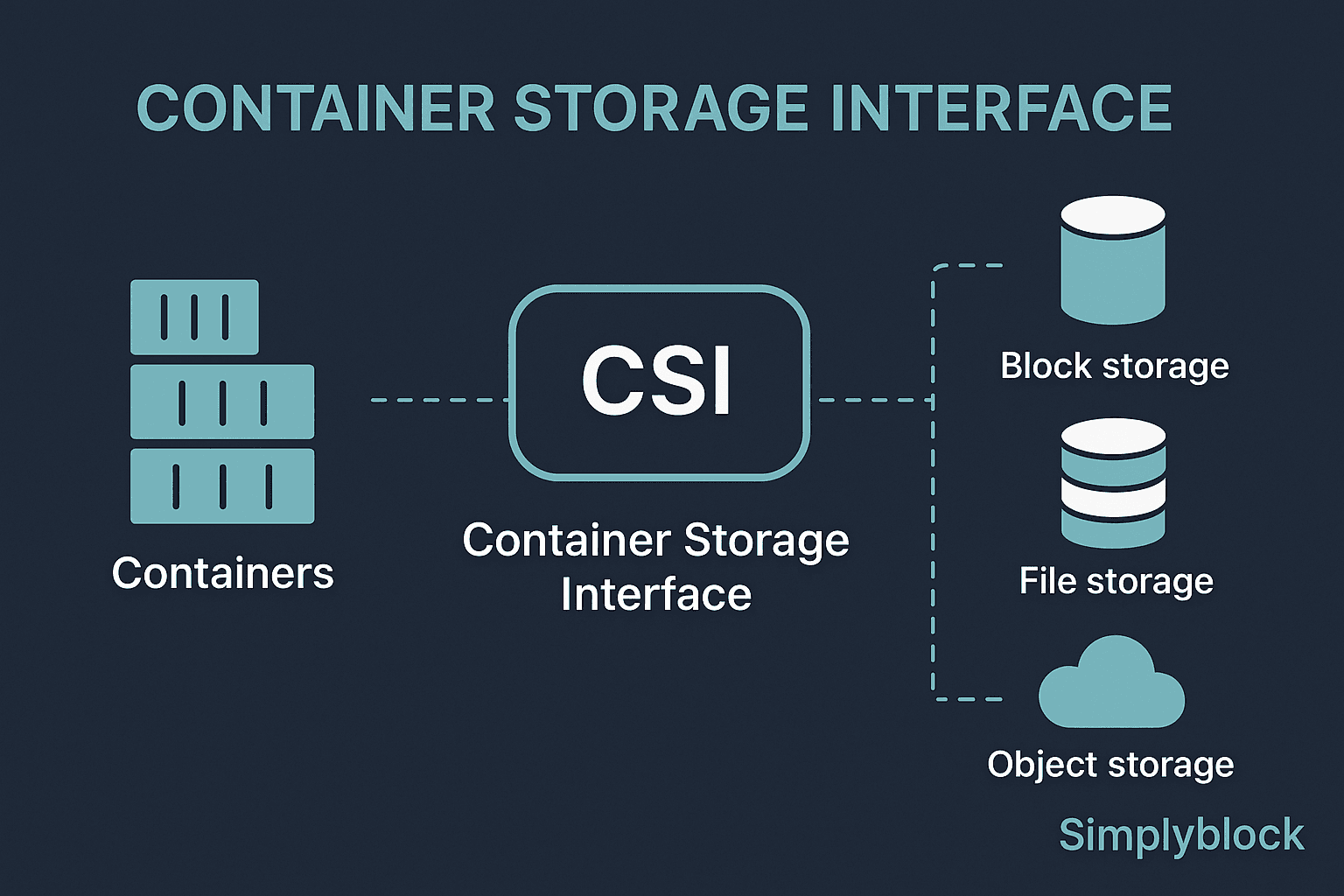Container Storage Interface
Terms related to simplyblock
The Container Storage Interface (CSI) is a standardized API that enables container orchestrators—like Kubernetes, OpenShift, or Rancher—to provision and manage storage dynamically, regardless of the underlying storage backend. Developed by the Cloud Native Computing Foundation (CNCF) and supported by major vendors, CSI removes the need for custom in-tree drivers, enabling consistent storage behavior across environments.
For enterprise environments running stateful applications on Kubernetes, CSI is essential. It acts as the bridge between workloads and storage, supporting dynamic volume provisioning, snapshotting, cloning, and data persistence, without tying the cluster to a specific storage vendor.
How CSI Works in Kubernetes
In Kubernetes, the CSI operates through three main components:
- CSI Driver: Installed in the cluster, it communicates with the storage backend.
- External Provisioner & Sidecars: Helper containers that automate volume lifecycle operations.
- Persistent Volume (PV) & Persistent Volume Claim (PVC): Standard Kubernetes abstractions that map to storage volumes created by the CSI driver.
When a developer defines a PVC in a Kubernetes deployment or StatefulSet, the CSI driver handles dynamic provisioning through the backend storage platform, such as simplyblock.
This allows workloads like PostgreSQL, Redis, and Cassandra to retain data across pod rescheduling and node failures.
Why CSI Replaced In-Tree Plugins
Before CSI, Kubernetes used in-tree storage plugins, which were hardcoded and maintained within the Kubernetes core. This created upgrade friction, vendor lock-in, and inconsistent feature support.
With CSI, storage vendors like simplyblock can develop and release out-of-tree drivers independently, ensuring faster updates, security isolation, and full feature parity across platforms. CSI has now reached GA and is the official standard for all Kubernetes storage integrations.

CSI vs In-Tree Storage Plugins
Understanding how Kubernetes handles storage is key to building reliable systems. This comparison breaks down the shift from in-tree plugins to CSI.
| Feature | CSI (Out-of-Tree) | In-Tree Plugins (Legacy) |
|---|---|---|
| Plugin Lifecycle | Decoupled from Kubernetes | Tied to Kubernetes release |
| Storage Vendor Flexibility | High | Limited |
| Feature Updates | Frequent, independent | Slower |
| Kubernetes Compatibility | All distributions | Limited versions |
| Standardization | CNCF Spec | Ad-hoc per plugin |
| Future Support | Fully supported | Deprecated |
Benefits of CSI for Kubernetes Storage
The CSI standard offers major advantages for DevOps, platform engineers, and architects:
- Dynamic provisioning: Volumes created on-demand via PVCs.
- Portability: Decoupled storage logic means switching backends is easier.
- Snapshot and clone support: Instant recovery or duplication of volumes.
- Scalability: Works across multi-zone, multi-cloud, and hybrid setups.
- Vendor-neutral: Works with software-defined storage platforms like simplyblock, as well as AWS EBS, GCP PD, and Ceph.
Use Cases of CSI in Enterprise Environments
CSI is now used across production-grade environments for:
- Stateful apps on Kubernetes: Databases, message queues, analytics pipelines.
- Multi-tenant storage: With QoS enforcement and isolation.
- CI/CD platforms: Instant snapshots and clones for test environments.
- Hybrid and edge deployments: Unified volume management across geographies.
- Disaster recovery and backups: CSI supports volume snapshotting and integration with backup tools.
CSI and Simplyblock™ Integration
Simplyblock delivers high-performance, CSI-compliant storage with:
- Sub-millisecond latency using NVMe-over-TCP
- CSI-based provisioning of block volumes in Kubernetes, OpenShift, and Rancher
- Advanced erasure coding for data protection
- Instant snapshots, clones, and volume resizing
- Full multi-tenancy for DBaaS or internal platform use cases
You can explore our Kubernetes CSI integration guide for technical details.
External Resources
- CSI Developer Documentation – Kubernetes
- Container Storage Interface – CNCF GitHub
- Persistent Volumes – Kubernetes Docs
- Kubernetes Volumes and Storage Classes – DigitalOcean
Questions and Answers
CSI drivers standardize how storage is integrated into Kubernetes, enabling dynamic volume provisioning across different backends. They allow seamless support for cloud, on-prem, and NVMe over TCP systems without modifying the Kubernetes core.
CSI decouples storage logic from Kubernetes itself, allowing for more flexibility and faster innovation. Paired with Kubernetes-native NVMe storage, it enables scalable, high-performance storage provisioning for stateful workloads.
In-tree drivers are tightly coupled to Kubernetes and require updates to the core. CSI drivers operate independently, making them more modular and easier to maintain. This shift supports dynamic integration with software-defined storage platforms.
CSI itself doesn’t handle encryption, but it supports passing parameters to storage backends. For secure workloads, you can implement encryption at rest at the volume level, ensuring isolation and compliance for each tenant or namespace.
Yes, CSI can be used with NVMe over TCP through compatible storage drivers. Platforms like Simplyblock deliver NVMe/TCP-enabled volumes that are dynamically provisioned via CSI, combining speed, scalability, and Kubernetes-native compatibility.
